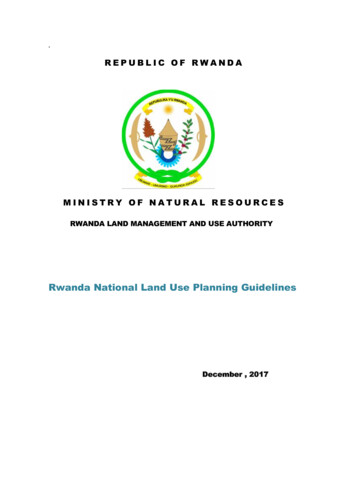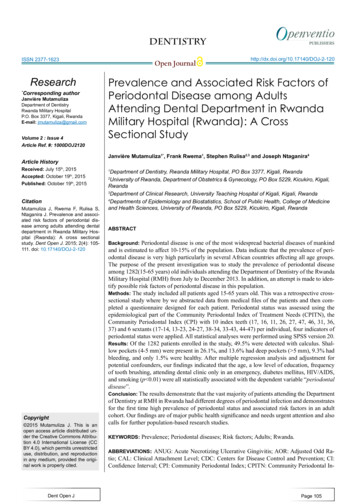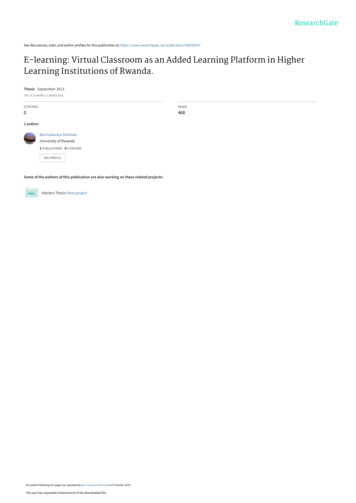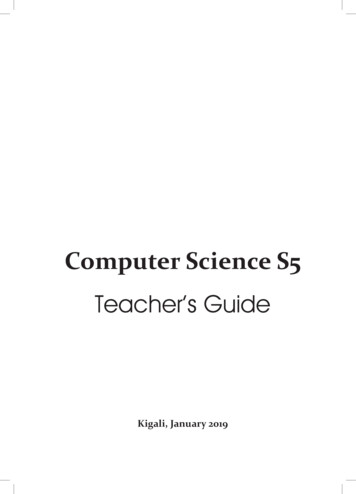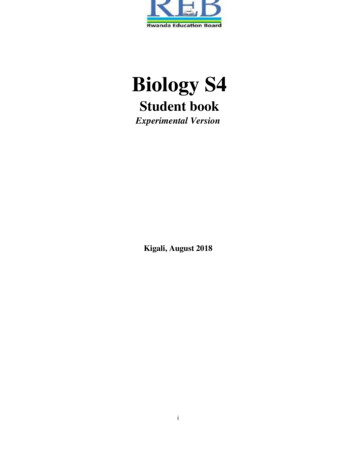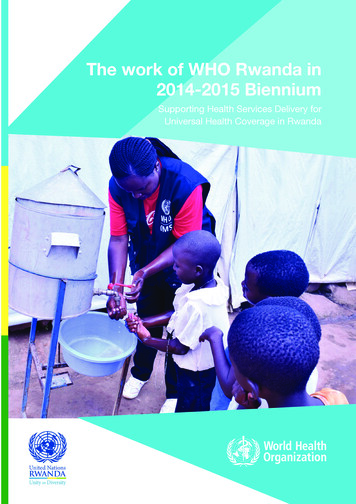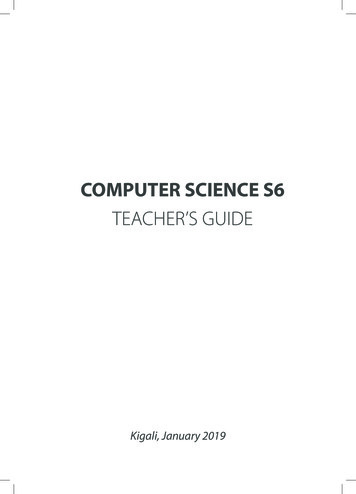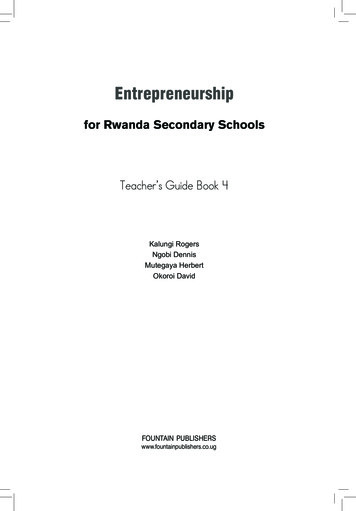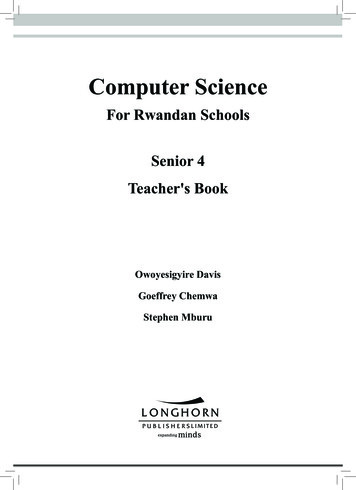
Transcription
Computer ScienceFor Rwandan SchoolsSenior 4Teacher's BookOwoyesigyire DavisGoeffrey ChemwaStephen Mburu
Published byLonghorn Publishers (Rwanda) Ltd166 KG 13 off KG 11 AvenueP.O. Box 5910Kigali, RwandaLonghorn Publishers LtdFunzi Road, Industrial AreaP.O. Box 18033-00500Nairobi, KenyaLonghorn Publishers (U) LtdKanjokya Street, Plot 74KamwokyaP.O. Box 24745Kampala, UgandaLonghorn Publishers (T) LtdNew Bagamoyo Road/Garden RoadMikocheni B, Plot No. MKC/MCB/81P.O. Box 1237Dar es Salaam, Tanzania O. Davis, S. Mburu, G. Chemwa, 2016All rights reserved. No part of this publication may be reproduced, storedin a retrieval system or transmitted in any form or by any means, electronic,mechanical, photocopying, recording or otherwise without the prior writtenpermission of the Copyright owner.First published 2016ISBN 978 9997 74 490 6Printed by Printed by Printwell Ltd.,Road “A” off Enterprise Road, Industrial Area,P. O. Box 5216 - 00506,Nairobi, Kenya.
ContentsIntroduction. 1Basic information. 1Pedagogial approaches. 14Planning for teaching. 22Assessment. 27Content Map. 31Unit 1: Computer Fundamental. 48Unit 2: Computer Architecture, Assembling anddisassembling Computer. 57Unit 3: Safe and Ethical Use of Computers. 71Unit 4: Computer Software Installation. 79Unit 5: Number Systems. 86Unit 6: Boolean Algebra and Logic Gates. 101Unit 7: Introduction to Computer Algorithm. 110Unit 8: Control Structures and Arrays. 121Unit 9: Introduction to Computer Programming. 131Unit 10: Introduction to C Programming. 140Unit 11: Operators and Expressions C Programming. 151Unit 12: Control Statements in C . 159Unit 13: Functions in C Programming. 168Unit 14: Arrays in C Programming. 177Unit 15: Introduction to Operating Systems.184Unit 16: HTML–Based WEB Development. 193Unit 17: Cascading Style Sheets.203iii
iv
INTRODUCTIONSection 1Basic information1.1 Organisation of the book–This teacher’s guide is organised intotwo main sections. Part 1 is the generalintroduction section detailing pedagogical issues. Part 2 is the main topics area. Itgives the details of the expected learningunits as organised in the learner’s book.The main elements of Part 2 are: Topic Area page - detailing thevarious Sub-topic Areas and theunits covered under the topic area. Unit heading – this is accompaniedby some text in the Student’s Book tomotivate the learners. Also, the total number of periods per unit is given. Key Unit Competence: This is thecompetence, which will be achievedonce students have met all the learningobjectives in the unit. Outline of main sections in the unit– is a quick summary of the subtopics covered under the unit. Learning Objectives: The contentin this area is broken down into threecategories of learning objectives, that is, knowledge and understanding;skills; attitudes and values.– Knowledge and understanding: Asin the existing curriculum, knowledgeand understanding is very important.– Skills: It is through the skills that students apply their learning andengage in higher order thinking. Theseskills relate to the upper levels of1Bloom’s taxonomy and they lead todeep rather than surface learning.Attitudes and values: This capturesappropriate attitudes and values thatrelate to the unit.Links to other subjects: It isimportant for learners to gain anunderstanding of the interconnectionsbetween different subjects so thatlearning in each subject is reinforcedacross the curriculum. This platformdoes exactly that. It prepares theteacher to pass this information to thelearners so that they are aware!Assessment Criteria: This is meantto evaluate whether learners havesucceeded in achieving the Key UnitCompetence(s) intended. This sectionwill help the teacher in assessingwhether the unit objectives have beenmet.Background information: This isthe introduction part of the unit. Itaims at giving insights to the teacheron the subject matter.Additional information for theteacher: This section gives moreinformation than what the syllabusrecommends for purposes of preparingthe teacher to answer tough questionsfrom learners.Learning Activities: These aregiven per lesson and have these subsections:
–––––––––––Lesson titlesSpecific objectives of the lessonMaterials and learning resourcesTeaching ic competencies coveredCross-cutting issues coveredSpecial needs and multi-abilitylearningFormative assessmentExtended exercises/activitiesfor fast learners and remedial(reinforcement)exercises/activities for slow learners.Answers to self-evaluationexercises These are repeated across all periodsuntil the end of the unit followed bythe answers or tips on the test yourcompetence questions at the end ofevery unit. 1.2 The Structure of the syllabusComputer science is a competencebased syllabus for combinations subjectis taught and learned at Advanced Level.The syllabus is structured in TopicAreas, and then further broken downinto Units. The units have the followingelements: Number of Periods required tocover each topic.Key Unit Competency whoseachievement is pursued by allteaching and learning activitiesundertaken by both the teacher andthe learners. The Key Competencyis broken into three types of learningobjectives as follows:– Type I: Learning Objectivesrelating to Knowledge andUnderstanding. These areassociated with Lower OrderThinking Skills or LOTS.– Type II and Type III: These LearningObjectives relate to acquisitionof skills, Attitudes and Values.They are associated withHigher Order Thinking Skills orHOTS.– These Learning Objectives areactually considered to be theones targeted by the presentreviewed syllabus.Content area which indicates thescope of coverage of what a teachershould teach and learner shouldlearn in line with stated objectives,skills and attitude.Suggested teaching and learningactivities that are expected toengage learners in an interactivelearning process as much as possible(learner-centered and participatoryapproach).Link to other subjects, assessmentcriteria and materials (or resources)that are expected to be used inteaching and learning process.The Computer Science syllabus forSenior 4 has 17 units. These units havebeen covered by the following units inthe student's book:1. Computer Fundamentals2. Computer Architecture and Assembly2
3. Safe and ethical use of computers.the national curriculum in Rwandaneducation system. As part of the changesin the curriculum, Computer Sciencesyllabus was reviewed to ensure that thesyllabus is responsive to the needs of thelearner with a shift from knowledge-basedlearning to competence-based learning.Another reason for curriculum reviewwas inclusion of the computer sciencecomponent leading to the new subjectnamed “Computer Science CompetenceBased Syllabus.”4. Computer Software Installation5. Number Systems6. Boolean Algebra and Logic Gates7. Introduction to Computer Algorithm8. Controlstructuresdimension arrayand9. IntroductionProgrammingComputertoone10. Introduction to C programming11. Operators and Expression in C Apart from being integrative, the newsyllabus guides the interaction betweenthe teacher and the learner in thelearning process. It further puts greateremphasis on skills a learner shouldacquire during each unit of learning. As acompetency-based syllabus, it elaborateson the competence-based aspects ofknowledge, skills and attitudes andvalues in computer science.12. Control Statements in C 13. Function in C Programming14. Arrays in C Programming15. Introduction to Operating Systems16. HTML-Based Web Development17. Cascading Style Sheet1.3Background Information onthe new curriculumThe goal of computer science is todevelop a competence-based societythat fits in the globalization processcharacterised by knowledge economyand competition. Competence-basedlearning refers to systems of instruction,assessment, grading, and academicreporting that are based on studentsdemonstrating that they have acquiredand learned the prerequisite knowledge,skills and attitudes as they progressthrough their education.The competence based curriculumis in line with various governmentpolicies and aspirations as stipulated invarious policy documents including TheEducation Sector Strategic Plan 2013and Vision 2020 that emphasis qualityeducation and put a lot of emphasison science, technology and innovation;Poverty Reduction Strategy (EDPRSII)and the draft ICT Policy in Education2014 that stresses the need to avail ICTto all learners. The need to addressall these aspirations necessitated acomprehensive review of the LowerSecondary CurriculumThis is the motivation behind paradigmshiftfromknowledge-basedtocompetence-based curriculum thatresulted to comprehensive review of3
1.4 Rationale of teaching andlearning Computer ScienceLiteracy Reading a variety of textsaccurately and quickly. Expressing ideas, messages andevents through writing legibletexts in good hand-writing withcorrectly spelt words. Communicating ideas effectivelythrough speaking using correctphonetics of words. Listeningcarefullyforunderstanding and seekingclarification when necessaryii) Numeracyi)Computer science is a powerful subjectof modern life which has changed everyaspect to the human society. Withcomputer science, different computingdevices have been developed and theyare helping in daily life. It is importantto highlight inventions of computers,embedded systems, telephony forcommunication, and automation ofdifferent human activities throughdifferent applications facilities, usage ofcomputing technologies in medicines,education, finance, socio-economic,military, security, spatial sciences, andweather ethecountrydevelopment through communication,corporategrowth,economicdevelopment, financial transaction, jobcreation, foster the value of investments,living standards, patterns of work andleisure.l1.5 Computing and convertingnumbers in the four basesystems: decimal, binary, octaland hexadecimal. Using algorithms and computerprograms to manipulatenumbers, symbols, quantities,computer memory, and othercomputing tasks. Using computer programsto solve problems relatedto everyday activities likecommercialandfinancialmanagement. Interpreting basic statisticaldata using programs, tables,diagrams and charts.Generic competencesTypes of Competences andtheir acquisitionThe national policy documents, based onthe national aspirations, identify ‘BasicCompetences’ alongside the ‘GenericCompetences’ that will develop higherorder thinking skills.b)Genericcompetencesmustbeemphasized and reflected in the teachingand learning of computer science. Thenational policy documents, based onthe national aspirations, identify ‘Basica) Basic competencesBasic competences are addressed inthe broad subject competences and inobjectives include:4
Competences’ alongside the ‘GenericCompetences’ that will develop higherorder thinking skills. Basic Competenciesare addressed in the stated broad subjectcompetences and in the objectiveshighlighted on year basis and in each of theunits of learning.not being teachers of language, willensure the proper use of the languageof instruction by learners which willhelp them to communicate clearly andconfidently. It will also assist learnersto convey ideas effectively throughspeaking and writing and by using thecorrect language structure and relevantvocabulary.The selection of types of learning activitiesmust focus on what competencies thelearners are able to demonstrate throughoutand at the end of the learning process. Basiccompetencies must be emphasised duringteaching and learning process.5. Cooperation, inter personalmanagement and life skills: This willhelp the learner to cooperate withothers as a team in whatever task areassigned and to practice positive ethicalmoral values and respect for the rights,feelings and views of others. Learnerswill also perform practical activitiesrelated to environmental conservationand protection. These skills will alsoassist learners to advocate for personal,family and community health, hygieneand nutrition and respond creatively tothe variety of challenges encountered inlife.They are briefly described below andteachers must ensure that learnersare engaged in tasks that help them toacquire the competences.1. Critical thinking and problemsolving skills: The acquisition ofthese skills will help learners thinkimaginatively and broadly to evaluate andfind solutions to problems encounteredin all situations.2. Creativity and innovation: Theacquisition of these skills will help learnerstake initiative and use imagination beyondthe knowledge provided to generatenew ideas and construct new concepts.6. Lifelong learning: The acquisitionof this skill will help learners to updatetheir knowledge and skills with minimumexternal support and to cope with theevolution of knowledge advances forboth personal fulfillment and in areas thatneed improvement and development.3. Research skills: This will helplearners find answers to questions basedon existing information and concepts andto explain phenomena based on findingsfrom information gathered.1.6 Computer Science anddeveloping competencesComputer Science contributes to alearner’s development of critical thinking,research and problem solving, creativity4.Communicationinofficiallanguages: Teachers, irrespective of5
and innovation, communication andcooperation skills. This will be achievedby conceptualising, analysing, synthesising,evaluating, manipulating and applyingvarious programming techniques, databasemanagement and networking to appropriatecontexts of real lifemaking generalizations out of limitedinformation. They should be openminded and able to distinguish betweenpropaganda and truth.Some of the Computer Science attitudesthat learners should develop include: Through computer science, learners willidentify problems and conduct analysis byconsidering relevant functional, practical,human and socioeconomic factors. Theywill also draw up specifications for thecomputer-based solutions to problemsfrom a range of suitable resources. Computer science will also contributeto promotion of self-reliance ofRwandan through provision of necessaryknowledge, skills, attitude and values. Furthermore, computing solutions willenhance nation's integrity; peace andrespect of others which are key valuesfor development of the country.1.6 Important Attitudes inComputer Science1.6.1 Attitude in learners There are certain useful attitudes, whichthe teacher should help to develop in thelearners as they carry out investigationsin computer science. Computer scienceas a problem solving discipline is expectedto make an impact on a learner’s generalbehaviour.The nature of computer science methoddemands learners to be honest withthemselves as they record results andmake unbiased conclusions. They shouldalso be aware of the danger involved in 6Practical approach – to problemsolving. Learners should seek answersto their questions and problems bycarrying out investigations whereverpossible.Responsibility – A learner shouldbe responsible enough to effecttasks apportioned and take goodcare of apparatus during and afteran investigation.Cooperation – Learners willoften be working in groups whilecarrying out investigations and needtherefore to cooperate with allother members of the group.Curiosity – Learners should havea curious attitude as they observethings and events around them. Thisis the first step towards solving aproblem.Self-confidence–Learnersshould have the will to attempt tosolve a problem. The feeling of selfconfidence can be strengthened inyoung learners if they experiencemany small successes that winapproval and encouragement fromthe teacher. The problems whichlearners attempt to solve shouldnot be so difficult that they lead tofrustration.Honesty – As they makeobservations, record, analyse results
and draw conclusions.Patience – Learners shouldbe patient for the results of anexperiment which may take time tomanifest. Develop life skills,entrepreneurial skills Apply computational thinking, logicaland algorithmic precision in problemsolving and creativity.1.6.2 Attitude in teachers Engage students in variety of learningactivities Apply appropriate teaching andassessment methods Adjust instructions to the level ofthe learner Creativity and innovation Makes connections/relations withother subjects Show a high level of knowledge ofthe content Develop effective discipline skillsmanage adequately the classroom Good communicator Guide and counsellor Passion for children teaching andlearning. Do maintenance of computer hardwareand perform installation/uninstallationof software Use computer ergonomically to avoidhealth related risk Respect ethical issues related to piracy,software licensing, copyright, individualprivacy Apply the stages of the softwaredevelopment life cycle (i.e., problemdefinition, analysis, design, testing,implementation, maintenance) Identify errors in a program and applyprinciples of debugging Broad Computer ScienceCompetence sAnalyze cultural, legal, and ethical issuesand responsibilities of digital citizens,organizations, and government entities(e.g. privacy issues related to internetuse, data protection). Broad competences that must beemphasized and reflected in the teachingand learning process are highlightedbelow:Analyze issues related to malicioussoftware, social engineering, andsecurity awareness. Design small web-based, desktop andmobile applications Design, install, maintain and administera database Install and administer Windows andLinux kernel-based operating systems Maintain common technological tools Design, 1.7 Use computational competences tocontribute significantly to GDP growthby improving government services,business efficiency and productivity forlong term and sustainable minister
computer networks statements in C programCreate and capture images, audio,videos; edit them using appropriatesoftwareShow the following skills in his/hereveryday life: communication, research,practical problem solving, observation,creativity and innovative skills.Explain the computer system, evolution,role, architecture and classification Identify different numbers base systemsand perform conversion between them Identify different logic gates, theoremsof Boolean algebra and evaluate Booleanexpressions Utilize the laws of Boolean algebra onBoolean expressions and raw a simplelogic circuit using logic gates Integrate safety guidelines, ergonomicsand ethical issues to have a goodworking environment Dissemble and assemble computer, dominor maintenance Identify different computer ports andconnectors Derive a suitable algorithm for acomputational problem using variables,expressions, reading and writingfunctions, and loops Describe programming paradigms Transform an algorithm in C andapply functions, arrays and controlExplain the Evolution, role, types andfunction of the Operating System Build standards compliant web pagesusing XHTML and CSS1.9Cross-cutting issues to beinfused during learningThese are emerging issues which need tobe incorporated in the learning process.Each of the cross-cutting issues has itsown important programme of learningreflecting key national priorities. Thislearning is integrated into the syllabusesof subjects across the curriculum ratherthan each issue having a dedicatedtimetable slot of its own. As a result ofthis integration, the learning activitiesin the units of subjects across thecurriculum incorporate all the learningassociated with the cross-cutting issues.The eight cross-cutting issues are:1.8 Key competences at theend of Secondary 4 a) Peace and Values EducationThe need for Peace and Values Educationin the curriculum is obvious. Peace isclearly critical for society to flourish andfor every individual to focus on personalachievement and their contribution to thesuccess of the nation. Values educationforms a key element of the strategy forensuring young people recognise theimportance of contributing to society,working for peace and harmony andbeing committed to avoiding conflict.b) Financial EducationFinancial education makes a strong8
contribution to the wider aims ofeducation. It makes learning relevantto real life situations. It aims at acomprehensivefinancialeducationprogram as a precondition for achievingfinancial inclusion target and improvesthe financial capability of Rwandans.Financial education has a key role of notonly improving knowledge of personalbut also transforming this knowledgeinto action. It provides the tools forsound money management practices onearnings, spending, saving, borrowingand investing. Financial education enablespeople to take appropriate financialservices both formal and informal thatare available to them and encouragesfinancial behaviours that enhance theiroverall economic well-being.circumstances leading to the genocideand the remarkable story of recovery andre-establishing national unity. GenocideStudies helps learners to comprehendthe role of every individual in ensuringnothing of the sort ever happens again.The intent of a cross-cutting curriculumaround the topic of genocide is tofight against genocide, genocide denial,and genocide ideology; and to equipstudents with a more fundamental andcomprehensive understanding of thegenocide, thereby preventing furtherhuman rights violations in the futureand enabling Rwanda’s population ofyoung people to more competently andthoughtfully enter the workforce. So, itneeds to be emphasized.e) Environment and sustainabilityc) Standardisation CultureThe growing awareness of the impactof the human race on the environmenthas led to recognition of the need toensure our young people understandthe importance of sustainability as theygrow up and become responsible for theworld around them. One of the risingthreats to the environment is the poormanagement of e-waste. Leaners needskills and attitudes that will enable themin their everyday life to conserve theenvironment and adress climate changeissue and to have a sustainable ��understandingoftheimportance of standards as a pillarof economic development and in thepractices, activities and lifestyle of thecitizens. It is intended that the adoptionof standardization culture should havean impact upon health improvement,economic growth, industrialization,trade and general welfare of the people.While education is the foundation andstrength of our nation, standards are oneof the key pillars of sustainable economicdevelopment.f) Gender educationThere is a strong moral imperativeto afford every individual their basichuman rights. Gender inequality resultsin women and girls being treated lessd) Genocide StudiesGenocide Studies provides youngpeople with an understanding of the9
favourably than men. A strongly negativeimpact of unequal treatment, whichaffects the nation as a whole, is the factthat it results in women being held backand their talents and abilities not beingfully realised. With a good understandingof the principles of Gender Equality, itis intended that future generations willensure that the potential of the wholepopulation is realised.supports a rights- based approach inwhich values such as respect, acceptancetolerance, equality, empathy andreciprocity are inextricably linked touniversally agreed human rights. A clearmessage concerning these dangers andhow they can be avoided, from rightacross the curriculum,is the best wayto ensure that young people understandthe risks and know how to stay healthy.g) Comprehensive sexuality education(HIV/AIDS, STI, Family planning,Gender equality and reproductivehealth)h) Inclusive EducationInclusive education involves ensuringall learners are engaged in educationand that they are welcomed by otherstudents so that everyone can achievehis/her potential. Inclusive practiceembraces every individual regardless ofgender or ability including those withlearning difficulties and disabilities. Thealmost focus of inclusive curriculum ison ensuring participation in educationof learners with different learning stylesand other difficulties. To be successful,it entails a range of issues includingteacher’s positive attitudes, adaptingthe learning resources, differentiationof teaching and learning methods andworking together. Overall, the benefitsof an inclusive curriculum extend to alllearners.Comprehensive sexuality education,which is age appropriate, gender sensitiveand life skills based can provide youngpeople with the knowledge and skillsto make informed decisions about theirsexuality and life style. Preparing childrenand young people for the transition toadulthood has been one of humanity’sgreatest challenges with human sexualityand relationships at its core. Few youngpeople receive adequate preparationsfor their sexual lives. This leaves thempotentially vulnerable to coercion, abuseand exploitation. Unintended pregnancyand sexually transmitted infections(STIs) including HIV/AIDS. Many youngpeople approach adulthood faced withconflicting and confusing messagesabout sexuality and gender. This is oftenexacerbated by embarrassment, silence,disapproval and open discussion of sexualmatters by adults(parents, teachers) atvery time when it is most needed.Comprehensivesexuality1.7 Special needs education andinclusivityAll Rwandans have the right to accesseducation regardless of their differentneeds. The underpinnings of thisprovision would naturally hold that alleducation10
citizens benefit from the same menu ofeducational programs. The possibility ofthis assumption is the focus of specialneeds education. The critical issue isthat we have persons/ learners who aretotally different in their ways of livingand learning as opposed to the majority.The difference can either be emotional,physical, sensory and intellectual learningchallenges traditionally known as mentalretardation. These learners equallyhave the right to benefit from the freeand compulsory basic education in thenearby ordinary/mainstream schools.Therefore, the schools’ role is to enrolthem and also set strategies to providerelevant education to them. The teachertherefore is requested to considereach learner’s needs during teachingand learning process. Assessmentstrategies and conditions should alsobe standardised to the needs of theselearners. Also, ensure that you includelearners with special educational needs inclassroom activities as much as possible.supervision and assistance. The followingare some suggestions on how to supportspecial needs children in your class.(a) Learners with physicaldifficultiesIn this group of learners, the affectedareas are normally some body parts,especially the limbs. There may bepartial or total loss of use of the limbs.In case the legs are affected, the learnerswill need assistance during activities thatinvolve movement. This could be duringa nature walk and other activities thatlearners have to stand for some reason.The teacher should organize for thelearner’s ease of movement around.The learner should also be given time tocatch up with the others.In case the hands are affected, thelearners should be given more time tofinish their work. In both cases, thelearners should not be pressurized to dothings that can cause injury or ridicule.(b) Learners with visual difficultiesThese learners normally have problemswith their eyesight. They should sit in aposition where they are able to see thechalkboard without strainingThe special needs children can fall in anyof the following common categories: Physical difficultiesVisual difficultiesHearing difficultiesMental difficultiesGenocide traumatized learnersNote: The learner could be longsightedor short sighted.The material to be observed shouldbe brought closer to the learner and amagnifying lens used where necessary.The teacher should use large diagrams,charts and labels. In some cases, thelearners can be allowed to touch andfeel whatever they are looking at. Otherlearners can assist by reading aloud. TheThe teacher should identify such casesand help facilitate the affected learnerslearning. For example, learner’s withvisual and hearing difficulties shouldsit near the teacher’s table for easy1
Computer Science For Rwandan Schools Senior 4 Teacher's Book Owoyesigyire Davis Goeffrey Chemwa Stephen Mburu. Published by Longhorn Publishers (Rwanda) Ltd 166 KG 13 off KG 11 Avenue P.O. Box 5910 Kigali, Rwanda Longhorn Publishers Ltd Funzi Road, Industrial Area P.O. Box 18033-00500
